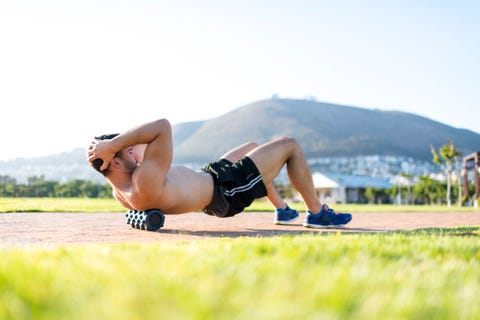
Your coach, trainer, and physical therapist have all been saying it for years: You need to stretch after every workout. Then came the uber popularity of foam rolling, and those same fitness experts praised the hurt-so-good pain that happens when you intentionally dig into self-myofascial release.
Now, it seems like stretching and foam rolling just isn’t enough—especially when you’re scrolling through Instagram. You wouldn’t be out of line if you think that nearly everyone you know is using next-level recovery techniques, whether they’re strapping on compression boots from Normatec and Rapid Reboot, shooting up with vibrational therapy (think Theragun and Hyperice), or putting on portable e-stim (we see you, PowerDot). Even hour-long infrared sauna sessions and cryotherapy are a thing these days.
It makes sense for people who get paid to work out all the time. If they’re not sweating, they’re not bringing in bank, so they need their bodies to perform. But for those of us who only work out once a day—heck, maybe only three to five times a week—are these treatments necessary? Or is smart marketing enticing us to spend more money than ever before? (No, seriously—a recent study suggests that millennials are now, on average, spending more money on fitness than they do on college tuition.)
Is Spending So Much Money on Recovery Worth It?
The answer: a little bit of both.
On one hand, these souped-up tools are just proof that the industry is moving forward as we learn more about the body and how to care for it properly. “The point of innovation in any industry is to allow us to function in a more efficient matter, or to build on top of and add to things that already exist,” Alain Saint-Dic, CPT, performance enhancement specialist and trainer at Stretch Relief in New York City, tells Mens Health. “Fitness professionals utilize these techniques for the very same reason that people use Uber or Seamless—there’s nothing wrong with hailing a yellow cab, or calling in an order for food, however innovation has made these processes more efficient.”
On the other hand, you don’t necessarily need these tools—a foam roller and stretching still get the job done if you’re not interested in investing so much of your cash into recovery. And, depending, on your experience, you may not be ready to level-up your game, according to David Reavy, an orthopedic physical therapist and founder of React Physical Therapy in Chicago.
“[You have to] take the necessary steps to get to that level,” Reavy explains. “If you can’t tolerate lying on a foam roller, you have no business using a [vibrational therapy device like] Theragun.” And if you try to progress too fast, it could end up being more painful than helpful. “I’ve had patients use them and cause a lot of bruising [because there’s] too much soft-tissue trauma,” he adds.
How to Know If You Should Try Next-Level Recovery Methods
To figure out if you’re ready, Reavy says to look at your current fitness routine carefully.
“I think it’s great for people who are working out much more frequently,” he says. Think: people training for ultramarathons or regularly busting out triathlon brick workouts. “[But] people who are just starting to work out need to strengthen the muscle before they massage it… you need to start with the basics.”
If it’s time to experiment, think about what type of recovery you’re after. Foam rolling is an active form, as you’re activating the muscle by moving with it, Reavy says.
“When you have a regimented protocol, you tend to come back stronger.”
But compression boots, vibrational devices, and infrared saunas are all passive, meaning you can just lay (or sit) there and reap the rewards without taxing your body more—which is probably why these options are so Insta-popular, too.
“I have to convince and remind my clients every single day that they should be using their foam rollers at home, [yet] I can’t get them to put their Hypervolts down,” Saint-Dic says.
In a perfect world, you’ll use both passive and active recovery methods, Jenna Baynes, DPT OCS, a board-certified clinical specialist at Hospital for Special Surgery in New York City, tells Mens Health. So even if your inner couch potato is drawing you toward those lie-down routines, you should still foam roll and stretch to help you maintain any flexibility gains you made during your workout—and maximize the effects of your routine, she says.
Recover, No Matter What

PixelCatchersGetty Images
Regardless of what you choose, the trend to focus on recovery is well overdue. After all, the end goal of any of these techniques is almost always the same, according to Saint-Dic: reduce inflammation and soreness, increase circulation so that more nutrients can reach your muscles, maintain range of motion, and allow the nervous system to rest so that it can fire efficiently.
“The recovery periods are when true adaptations in the body occur,” he says. “When you have a regimented protocol, you tend to come back stronger.”
In other words, quit skipping your cool-down, grab your tool of choice, and hop to it.
Source: Read Full Article